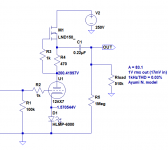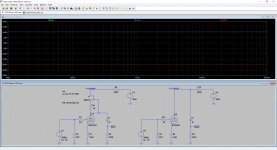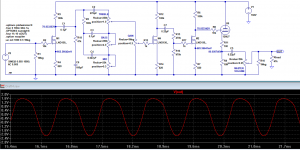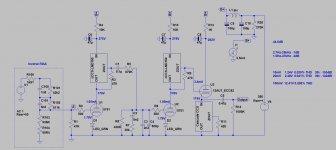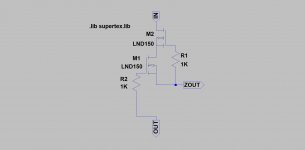I've been mucking around with 12AX7s lately.
In the middle of building a phono stage, which is sidetracked with power supply issues at the moment. But, I was thinking of ways to more easily put together a couple of 12AX7 gain stages, and I came up with something really simple -- put an LND150 high voltage/low current MOSFET as a CCS in the 12AX7 plate. (Diagram attached.)
The advantage I see is that you can get a healthy 1mA of plate current through your 12AX7 with only a 250VDC B+, and still have a high enough voltage at the cathode to keep the 12AX7 out of grid current.
I whipped up the example with an LND150 as a simple, single-device CCS for the plate load, and a red LED for the cathode load. The B+ is 250VDC.
The results are encouraging.
Lots of gain - over 80X.
Low THD if the stage is loaded lightly.
THD is all 2HD.
No high wattage resistors needed, so it's cheap.
The LND150 dissipates 54mW in this configuration. I figure that's quite safe.
Does anyone use this? If so, does it work well, or are there hidden gotchas?
--
In the middle of building a phono stage, which is sidetracked with power supply issues at the moment. But, I was thinking of ways to more easily put together a couple of 12AX7 gain stages, and I came up with something really simple -- put an LND150 high voltage/low current MOSFET as a CCS in the 12AX7 plate. (Diagram attached.)
The advantage I see is that you can get a healthy 1mA of plate current through your 12AX7 with only a 250VDC B+, and still have a high enough voltage at the cathode to keep the 12AX7 out of grid current.
I whipped up the example with an LND150 as a simple, single-device CCS for the plate load, and a red LED for the cathode load. The B+ is 250VDC.
The results are encouraging.
Lots of gain - over 80X.
Low THD if the stage is loaded lightly.
THD is all 2HD.
No high wattage resistors needed, so it's cheap.
The LND150 dissipates 54mW in this configuration. I figure that's quite safe.
Does anyone use this? If so, does it work well, or are there hidden gotchas?
--
Attachments
Check both the output noise level, and the bandwidth.
That is more of a mu follower circuit.
Hybrid Mu-follower Output Impedance – Bartola(R) Valves
That is more of a mu follower circuit.
Hybrid Mu-follower Output Impedance – Bartola(R) Valves
Last edited:
Back in the VT computer days didn't they have VT opamps? Hmm..
I suppose a choke load would have to have a hellacious amount of inductance for a high mu triode huh?
I suppose a choke load would have to have a hellacious amount of inductance for a high mu triode huh?
You guys... It's a simple mu-follower.
The problem this tries to address is that a DN2535 is not the best MOSFET for making a low current CCS/plate load (e.g., for 12AX7, 6SN7, etc.). People have found that it needs 3mA or more through it to work well.
The question is, would an LND150 make an acceptable CCS plate load for a 12AX7 mu-follower?
I suspect there's a reason people don't use LND150 on top of a 12AX7 this way. I'm curious to know why.
--
The problem this tries to address is that a DN2535 is not the best MOSFET for making a low current CCS/plate load (e.g., for 12AX7, 6SN7, etc.). People have found that it needs 3mA or more through it to work well.
The question is, would an LND150 make an acceptable CCS plate load for a 12AX7 mu-follower?
I suspect there's a reason people don't use LND150 on top of a 12AX7 this way. I'm curious to know why.
--
Is the LND150 a Depletion MOSFET?
If it is not made for Depletion Mode, it will not work as connected in the schematic.
If it is not made for Depletion Mode, it will not work as connected in the schematic.
From what I've read on here (didn't look for it, sorry) you can drop an LND150 into a circuit in place of a 12AX7 without changing values as long as you respect the Pd of the LND150.
And yes, it's a depletion MOSFET.
And yes, it's a depletion MOSFET.
Last edited:
Here's the data sheet for the Supertex LND150.
http://ww1.microchip.com/downloads/en/DeviceDoc/LND150 C041114.pdf
It's a depletion mode MOSFET in a TO92 package. It's different than others because of its high impedance, high voltage, low current operation. Like kodabmx said, the guitar amp folks use it as a solid state sub for 12AX7, in effects loops, effects pedals, stuff like that. I also read some posts from people who've wired them into tube sockets in place of 12AX7. So...
The reason I was asking about this is that if an LND150 is so similar to a 12AX7, putting one as a CCS in the plate of a 12AX7 would be a lot like making a mu-follower out of both sections of a 12AX7 tube, right? I figured it's so obvious, somebody must have tried it. I searched the googleverse and couldn't find this use of it. Source followers for tone stacks and effects loops, sure. But not the circuit I posted in post #1. Yet it's so obvious... Nobody's tried it? I'll have to.
I spiced a phono stage with a 6DJ8 input stage (low Cin, so good for Audio Technica MM carts) and a 12AX7 with LND150 mu-follower, DC-coupled to a MOSFET source follower. The result looks too good to be true. Lots and lots of clean gain from that 12AX7-LND150 mu-follower in simulation.
Anyway, that's why I asked.
--
EDIT TO ADD:
Looking at the data sheet, LND150 does indeed look a lot like a 12AX7. It says the forward transconductance is 2.0 millimhos, or 2000 umhos, very similar to 12AX7 (which is to say, pathetically low for a transistor).
The TO92 package can dissipate 700mW at 25 deg C, but only 550mW at 50C. That's really close to the 500mW max plate dissipation of a 12AX7. But these would usually be used with only about 50mW to 100mW Pd (maybe 50V across the device, 1mA). The attraction is that you can get the effects of using two 12AX7 triodes as a mu-follower from a much lower B+. A 12AX7 is going to need at least 170V plate-cathode to work with 1mA Ip, but an LND150 can work with 1mA Ids with only 40 or 50 Vds. A B+ of only 250V should be plenty to equal the performance of a 12AX7 mu-follower run from a 350V or 400V B+ supply. And of course the LND150 doesn't need a heater...
--
http://ww1.microchip.com/downloads/en/DeviceDoc/LND150 C041114.pdf
It's a depletion mode MOSFET in a TO92 package. It's different than others because of its high impedance, high voltage, low current operation. Like kodabmx said, the guitar amp folks use it as a solid state sub for 12AX7, in effects loops, effects pedals, stuff like that. I also read some posts from people who've wired them into tube sockets in place of 12AX7. So...
The reason I was asking about this is that if an LND150 is so similar to a 12AX7, putting one as a CCS in the plate of a 12AX7 would be a lot like making a mu-follower out of both sections of a 12AX7 tube, right? I figured it's so obvious, somebody must have tried it. I searched the googleverse and couldn't find this use of it. Source followers for tone stacks and effects loops, sure. But not the circuit I posted in post #1. Yet it's so obvious... Nobody's tried it? I'll have to.
I spiced a phono stage with a 6DJ8 input stage (low Cin, so good for Audio Technica MM carts) and a 12AX7 with LND150 mu-follower, DC-coupled to a MOSFET source follower. The result looks too good to be true. Lots and lots of clean gain from that 12AX7-LND150 mu-follower in simulation.
Anyway, that's why I asked.
--
EDIT TO ADD:
Looking at the data sheet, LND150 does indeed look a lot like a 12AX7. It says the forward transconductance is 2.0 millimhos, or 2000 umhos, very similar to 12AX7 (which is to say, pathetically low for a transistor).
The TO92 package can dissipate 700mW at 25 deg C, but only 550mW at 50C. That's really close to the 500mW max plate dissipation of a 12AX7. But these would usually be used with only about 50mW to 100mW Pd (maybe 50V across the device, 1mA). The attraction is that you can get the effects of using two 12AX7 triodes as a mu-follower from a much lower B+. A 12AX7 is going to need at least 170V plate-cathode to work with 1mA Ip, but an LND150 can work with 1mA Ids with only 40 or 50 Vds. A B+ of only 250V should be plenty to equal the performance of a 12AX7 mu-follower run from a 350V or 400V B+ supply. And of course the LND150 doesn't need a heater...
--
Last edited:
What is amazing to me is that the LND150 capacitances are quite low, permitting use in such stages as 12AX7s are used.
Makes sense, right? Miller effect. LND150 has very low hfe for a transistor, so internal capacitances are lower than in other transistors. But much less gain is available. However, that's still a bit more gain than a 12AX7.
So why can't I find a hybrid LND150-12AX7 mu follower anywhere? Strange.
I've found a lot of projects like 'making a solid state Marshall JTM800 preamp'
...
So why can't I find a hybrid LND150-12AX7 mu follower anywhere? Strange.
I've found a lot of projects like 'making a solid state Marshall JTM800 preamp'
...
A long long time ago, I messed with my Dynaco PAS-3 which, in stock form, had not enough gain in the phono section, and way too much gain in the line section, among other ailments, too many to list.
I attempted to insert a JFet current source in the plate as per the left circuit in the attachment; it worked, but was not an improvement. I finally remove it. Interestingly, the gain is the same at about 31dB; the limitation is the Rp of the tube, <100K, and the combined load resistance, including the Fet.
Subsequently, SY used DN2540 MOSfet in the His Master's Noise, which is roughly similar to your idea. Btw, the noise performance is that of the tube.
Because I have this non-negotiable constrain that the source is to be a low output MC cartridge, and if I had to allow anything silicon anywhere near my gear, it has to be right at the input, for noise reasons. So, my preferred topology for now is a JFet-Triode cascode.
I attempted to insert a JFet current source in the plate as per the left circuit in the attachment; it worked, but was not an improvement. I finally remove it. Interestingly, the gain is the same at about 31dB; the limitation is the Rp of the tube, <100K, and the combined load resistance, including the Fet.
Subsequently, SY used DN2540 MOSfet in the His Master's Noise, which is roughly similar to your idea. Btw, the noise performance is that of the tube.
Because I have this non-negotiable constrain that the source is to be a low output MC cartridge, and if I had to allow anything silicon anywhere near my gear, it has to be right at the input, for noise reasons. So, my preferred topology for now is a JFet-Triode cascode.
Attachments
Hey Zung, good points. Thanks for that info.
SY's "His Master's Noise" uses a D3a-triode as the input tube. That draws enough current to energize a DN2535 or DN2540.
Also, with a 364V B+ like you had in your Dyna PAS, there would be enough voltage available to drop to use a DN2535-nJFET cascode for a CCS plate load.
The problem here is how to do something similar but with a 12AX7, but with a lower 200V B+ available, where a plate resistor load is likely to require very low plate current (something like 500uA or even less) or very small grid bias (too close to 0V).
I will have to try this LND150-12AX7 mu-follower idea to see if it ends up being too noisy (hiss noise from the MOSFET).
If I'm trying to make a phono stage with a 12AX7 for the input stage, it will be for standard issue MM cartridges like the Audio Technical AT-VM95, Nagaoka or similar (or perhaps a Denon DL110 HOMC).
If I was making a phono stage meant for MC cartridges, I'd use fancier stuff like a 6DJ8 cascode, a 6S3P-EV, a triode-wired 6J9P, or similar. All those draw more plate current than a 12AX7, so a DN2535-based CCS would then be a usable possibility.
--
SY's "His Master's Noise" uses a D3a-triode as the input tube. That draws enough current to energize a DN2535 or DN2540.
Also, with a 364V B+ like you had in your Dyna PAS, there would be enough voltage available to drop to use a DN2535-nJFET cascode for a CCS plate load.
The problem here is how to do something similar but with a 12AX7, but with a lower 200V B+ available, where a plate resistor load is likely to require very low plate current (something like 500uA or even less) or very small grid bias (too close to 0V).
I will have to try this LND150-12AX7 mu-follower idea to see if it ends up being too noisy (hiss noise from the MOSFET).
If I'm trying to make a phono stage with a 12AX7 for the input stage, it will be for standard issue MM cartridges like the Audio Technical AT-VM95, Nagaoka or similar (or perhaps a Denon DL110 HOMC).
If I was making a phono stage meant for MC cartridges, I'd use fancier stuff like a 6DJ8 cascode, a 6S3P-EV, a triode-wired 6J9P, or similar. All those draw more plate current than a 12AX7, so a DN2535-based CCS would then be a usable possibility.
--
LND150 is used by guitar amp people to make preamps, effects loops and the like. I decided I'd try simulating a Fender/Boogie style guitar preamp to see if it looks like it would using 12AX7s. The answer is "pretty darn close". See attached.
I tried it with a ZVN0545 source follower, but the clipping was too sharp-edged. Dipping into Merlin Blencowe's "Designing Tube Guitar and Bass Preamps" I found the part about rounded clipping from a cathode follower drawing grid current. So I put a 12AU7 cathode follower at the end of the chain, and -1.2V grid bias (4.4mA plate current). That's how I got the rounded clipping shown in the attachment. But that is how it would work with 12AX7s too. Preamp clipping is sharp-edged in general.
--
I tried it with a ZVN0545 source follower, but the clipping was too sharp-edged. Dipping into Merlin Blencowe's "Designing Tube Guitar and Bass Preamps" I found the part about rounded clipping from a cathode follower drawing grid current. So I put a 12AU7 cathode follower at the end of the chain, and -1.2V grid bias (4.4mA plate current). That's how I got the rounded clipping shown in the attachment. But that is how it would work with 12AX7s too. Preamp clipping is sharp-edged in general.
--
Attachments
About a decade I planned to mod my (heavily modded) Audio Innovations 200 phono with LND150 cascode CCSs ... but then I didn't have enough FETs ... and later when I had enough, I used its to Ale's "gyrator". 😛
It's a plan:
It's a plan:
Attachments
...
I will have to try this LND150-12AX7 mu-follower idea to see if it ends up being too noisy (hiss noise from the MOSFET).
...
If I was making a phono stage meant for MC cartridges, I'd use fancier stuff like a 6DJ8 cascode, a 6S3P-EV, a triode-wired 6J9P, or similar...
Usually, noise is not a big deal as long as the main device has a voltage gain (or equivalent) >3: this is my rule of thumb.
The 6DJ8 is a good candidate for LOMC, event though its noise performance is borderline. I've been happily running a simple 1 stage pre-preamp for 30+ years now, and the only solid-state gear I have that comes close is the mckinnie RO II designed by John Curl, no less.
... I decided I'd try simulating a Fender/Boogie style guitar preamp to see if it looks like it would using 12AX7s. The answer is "pretty darn close". See attached.
...
Preamp clipping is sharp-edged in general.
--
I never liked the "Boogie way" of relying on a single preamp stage to create distortion: it's a grossly simplified way to provide more colors to the "tone", like eating a steak with pepper and no salt. Interestingly, I prefer what comes out of digital modeling software such as AmpliTube, but that's only me.
Ideally, there should be complexities provided by a good mix of distortions from the preamp, the amp, and the speakers: think Clapton during the Cream era in the sixties. A good passive attenuator gets you most of the way there, minus the speakers.
The LND150 preamp idea was just to illustrate that the device really does work a lot like a 12AX7, that's all.
But let's not digress into guitar amp tone. I agree with you about the mix of preamp, power amp, and speaker distortions being the key to a great sound.
--
But let's not digress into guitar amp tone. I agree with you about the mix of preamp, power amp, and speaker distortions being the key to a great sound.
--
A...a JFet current source in the plate as per the left circuit in the attachment; it worked, but was not an improvement.....
You have a "current source" and a 270k resistor in series. Who is in charge here?
The JFET will break-down at 40V-50V Drain-Gate(and Source). Like a Zener diode. Fixed voltage. So no wonder there was no improvement. Performance was worse but not by so much it mattered.
Zung,
In your Post # 11, you said:
" So, my preferred topology for now is a JFet-Triode cascode."
Your schematic in Post # 11 is not a cascode circuit.
But now you have me interested in that kind of cascode circuit.
Would you please post a schematic of your JFet-Triode cascode?
Thanks!
In your Post # 11, you said:
" So, my preferred topology for now is a JFet-Triode cascode."
Your schematic in Post # 11 is not a cascode circuit.
But now you have me interested in that kind of cascode circuit.
Would you please post a schematic of your JFet-Triode cascode?
Thanks!
About a decade I planned to mod my (heavily modded) Audio Innovations 200 phono with LND150 cascode CCSs ... but then I didn't have enough FETs ... and later when I had enough, I used its to Ale's "gyrator". 😛
I looked at Ale's gyrator circuit with LND150, but I couldn't get the cCCS-LND150 model to run in LTspice. How did you get yours working? Would you be willing to share the .sym (symbol) file with us/me? Thanks.
- Home
- Amplifiers
- Tubes / Valves
- Simple building block for high gain preamps - 12AX7 with single LND150 for CCS?
